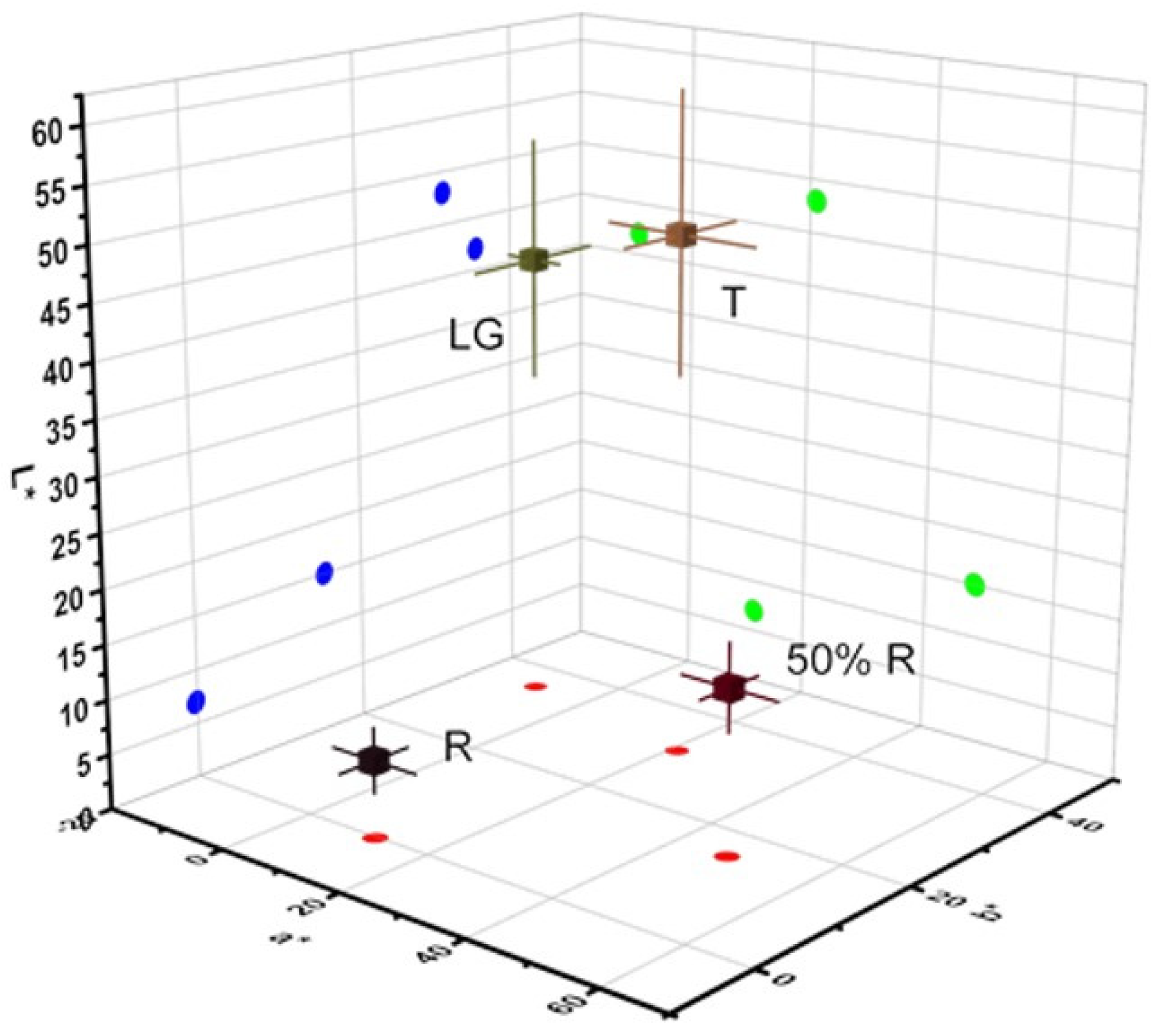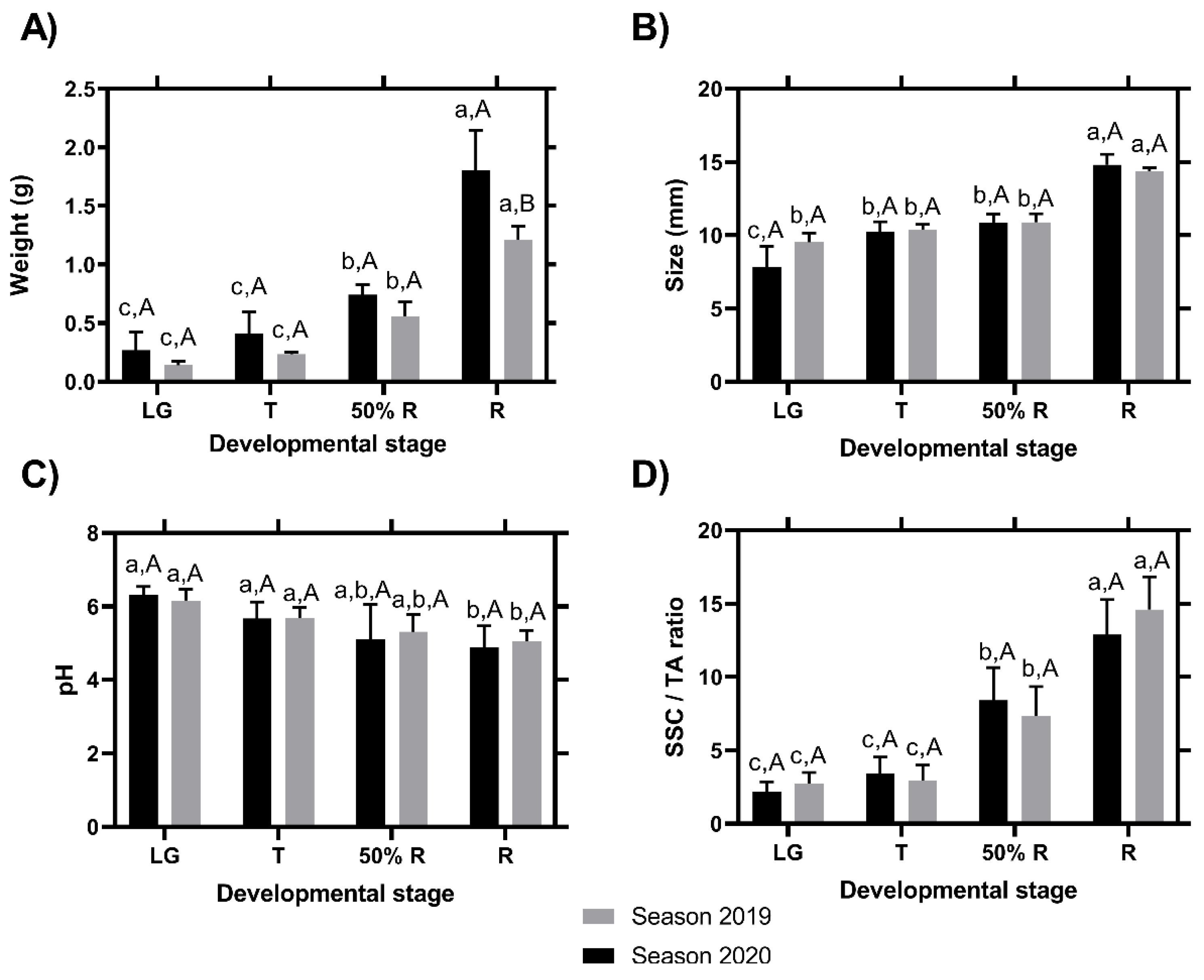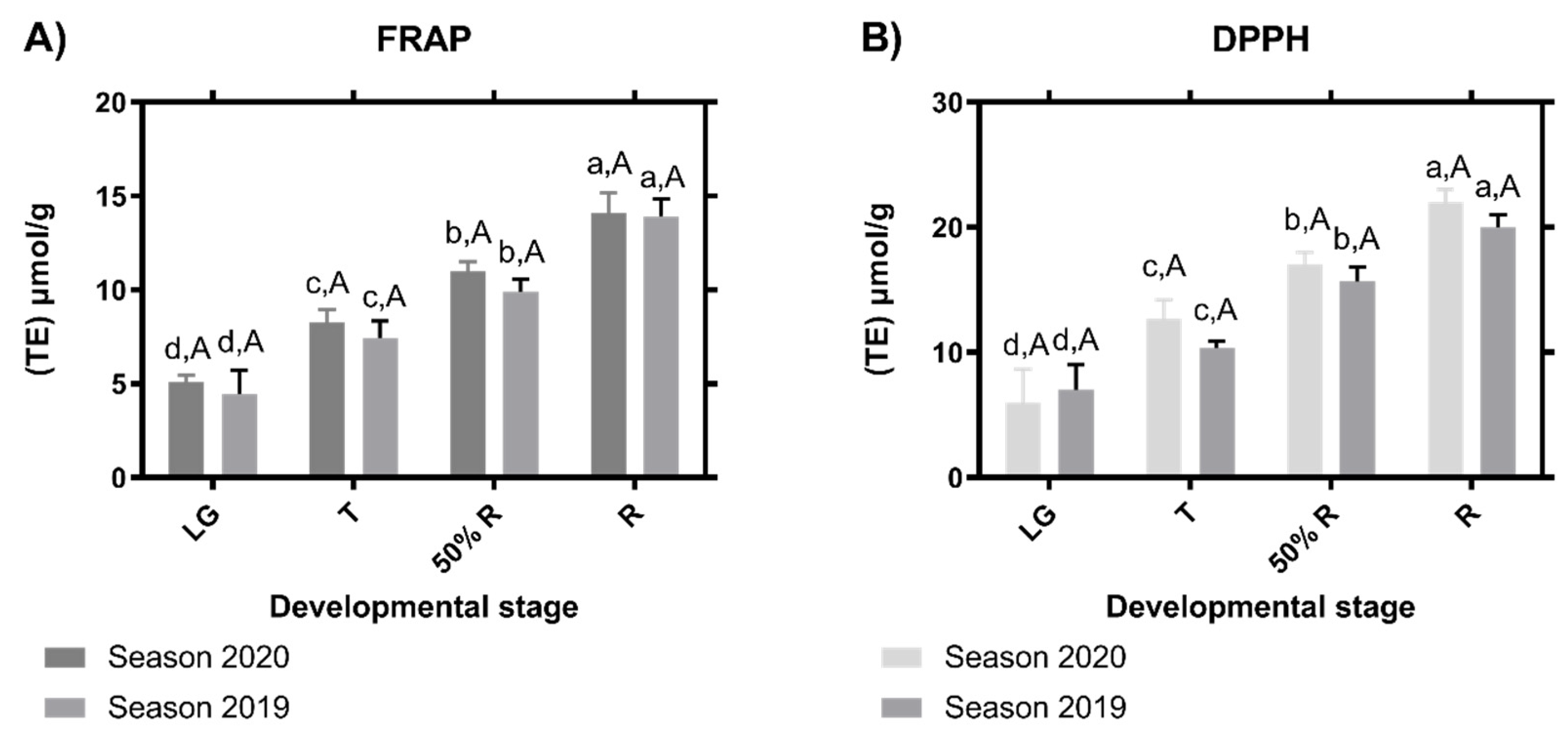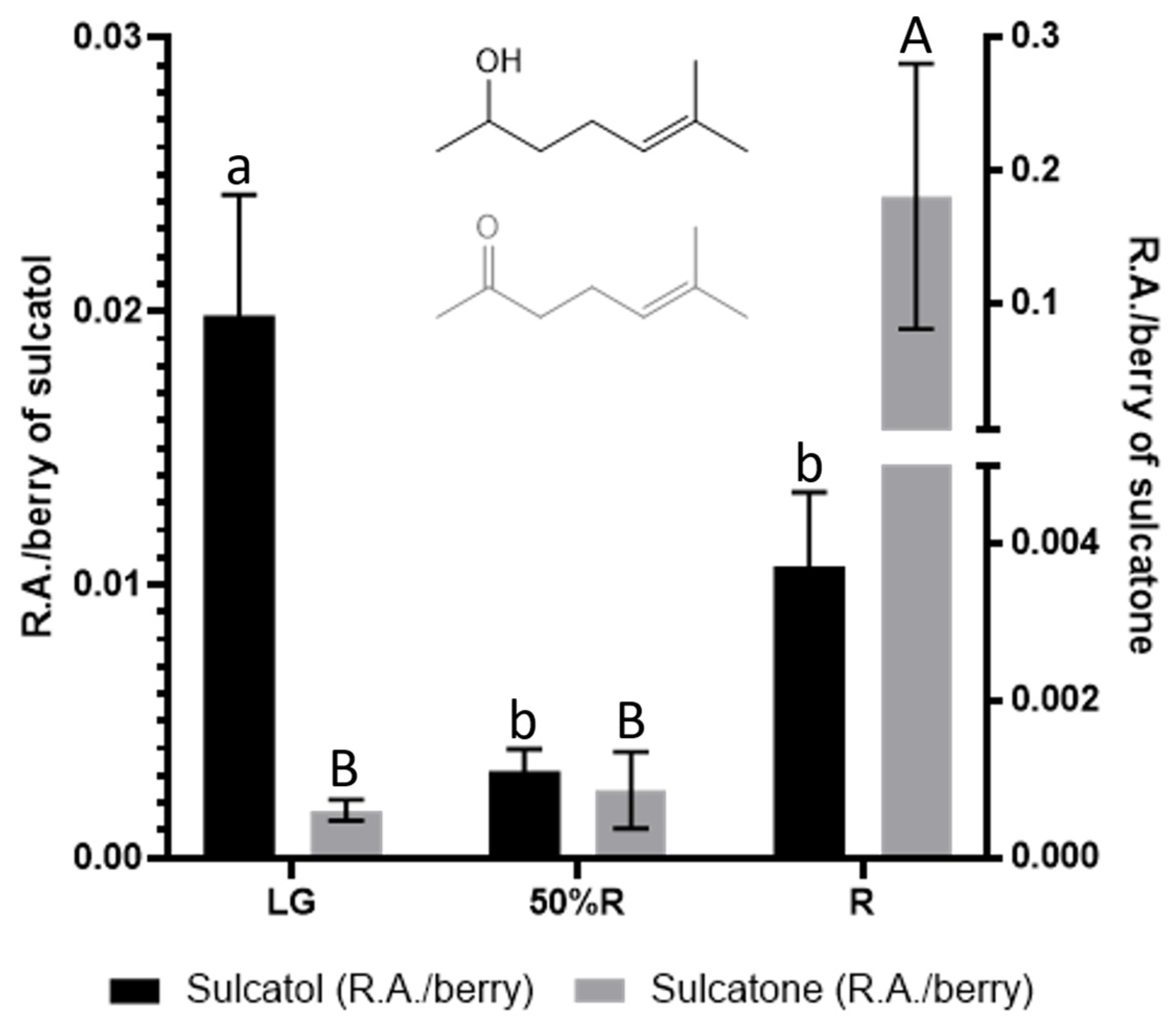Evolution of the Volatile Organic Compounds, Phenols and Antioxidant Capacity during Fruit Ripening and Development of Rubus ulmifolius Schott Fruits
Abstract
1. Introduction
2. Material and Methods
2.1. Fruit Samples
2.2. Physiological Parameters Determination
2.3. Total Antioxidant Capacity
2.4. Phenolic Composition
2.5. Volatile Organic Compounds (VOCs) of R. ulmifolius Schott Fruits
2.6. Statistical Analysis
3. Results
3.1. Fruit Development Parameters
3.2. Phenolic Composition
3.3. Antioxidant Capacity
3.4. Determination of VOCs of R. ulmifolius Schott Fruits
4. Discussion
5. Conclusions
Supplementary Materials
Author Contributions
Funding
Acknowledgments
Conflicts of Interest
References
- Martins, A.; Barros, L.; Carvalho, A.M.; Santos-Buelga, C.; Fernandes, I.P.; Barreiro, F.; Ferreira, I.C.F.R. Phenolic extracts of Rubus ulmifolius Schott flowers: Characterization, microencapsulation and incorporation into yogurts as nutraceutical sources. Food Funct. 2014, 5, 1091–1100. [Google Scholar] [CrossRef] [PubMed]
- Lorenzi, H.; Bacher, L.; Lacerda, M.; Sartori, S. Frutas Brasileiras e Exóticas Cultivadas; Instituto Plantarum de Estudos da Flora: São Paulo, Brazil, 2006; p. 672. [Google Scholar]
- D’Agostino, M.F.; Sanz, J.; Sanz, M.L.; Giuffrè, A.M.; Sicari, V.; Soria, A.C. Optimization of a Solid-Phase Microextraction method for the Gas Chromatography–Mass Spectrometry analysis of blackberry (Rubus ulmifolius Schott) fruit volatiles. Food Chem. 2015, 178, 10–17. [Google Scholar] [CrossRef] [PubMed]
- Oszmiański, J.; Nowicka, P.; Teleszko, M.; Wojdyło, A.; Cebulak, T.; Oklejewicz, K. Analysis of Phenolic Compounds and Antioxidant Activity in Wild Blackberry Fruits. Int. J. Mol. Sci. 2015, 16, 14540–14553. [Google Scholar] [CrossRef] [PubMed]
- Bowen-Forbes, C.S.; Zhang, Y.; Nair, M.G. Anthocyanin content, antioxidant, anti-inflammatory and anticancer properties of blackberry and raspberry fruits. J. Food Compost. Anal. 2010, 23, 554–560. [Google Scholar] [CrossRef]
- Zia-Ul-Haq, M.; Riaz, M.; De Feo, V.; Jaafar, H.Z.E.; Moga, M. Rubus fruticosus L.: Constituents, Biological Activities and Health Related Uses. Molecules 2014, 19, 10998–11029. [Google Scholar] [CrossRef] [PubMed]
- Nile, S.H.; Park, S.W. Edible berries: Bioactive components and their effect on human health. Nutrition 2014, 30, 134–144. [Google Scholar] [CrossRef]
- Padmanabhan, P.; Correa-Betanzo, J.; Paliyath, G. Berries and Related Fruits. In Encyclopedia of Food and Health; Caballero, B., Finglas, P.M., Toldrá, F., Eds.; Academic Press: Cambridge, MA, USA; Oxford, UK, 2016; pp. 364–371. [Google Scholar]
- Castro, R.I.; Ramos, P.; Parra-Palma, C.; Morales-Quintana, L. Ugni molinae fruit as a source of bioactive compounds with good quality traits. BioMed Res. Int. 2021, 2021, 6683877. [Google Scholar] [CrossRef]
- Ahmad, M.; Masood, S.; Sultana, S.; Ben Hadda, T.; Bader, A.; Zafar, M. Report: Antioxidant and nutraceutical value of wild medicinal Rubus berries. Pak. J. Pharm. Sci. 2015, 28, 241–247. [Google Scholar]
- Van de Velde, F.; Pirovani, M.E.; Drago, S.R. Bioaccessibility analysis of an- thocyanins and ellagitannins from blackberry at simulated gastrointestinal and co-lonic levels. J. Food Compos. Anal. 2018, 72, 22–31. [Google Scholar] [CrossRef]
- Tosun, I.; Ustun, N.S.; Tekguler, B. Physical and chemical changes during ripening of blackberry fruits. J. Sci. Agric. 2008, 65, 87–90. [Google Scholar] [CrossRef]
- Acosta-Montoya, Ó.; Vaillant, F.; Cozzano, S.; Mertz, C.; Pérez, A.M.; Castro, M.V. Phenolic content and antioxidant capacity of tropical highland blackberry (Rubus adenotrichus Schltdl.) during three edible maturity stages. Food Chem. 2010, 119, 1497–1501. [Google Scholar] [CrossRef]
- Gordon, A.; Gil Cruz, A.P.; Cabral, L.M.C.; de Freitas, S.C.; Taxi, C.M.A.D.; Donangelo, C.M.; Mattietto, R.D.A.; Friedrich, M.; da Matta, V.M.; Marx, F. Chemical characterization and evaluation of antioxidant properties of Açaí fruits (Euterpe oleraceae Mart.) during ripening. Food Chem. 2012, 133, 256–263. [Google Scholar] [CrossRef]
- Fu, Y.; Zhou, X.; Chen, S.; Sun, Y.; Shen, Y.; Ye, X. Chemical composition and antioxidant activity of Chinese wild raspberry (Rubus hirsutus Thunb.). LWT-Food Sci. Technol. 2015, 60, 1262–1268. [Google Scholar] [CrossRef]
- Schulz, M.; Borges, G.D.S.C.; Gonzaga, L.V.; Seraglio, S.K.T.; Olivo, I.S.; Azevedo, M.S.; Nehring, P.; de Gois, J.S.; de Almeida, T.S.; Vitali, L.; et al. Chemical composition, bioactive compounds and antioxidant capacity of juçara fruit (Euterpe edulis Martius) during ripening. Food Res. Int. 2015, 77, 125–131. [Google Scholar] [CrossRef]
- Seraglio, S.K.T.; Schulz, M.; Nehring, P.; Della Betta, F.; Valese, A.C.; Daguer, H.; Gonzaga, L.V.; Fett, R.; Costa, A.C.O. Nutritional and bioactive potential of Myrtaceae fruits during ripening. Food Chem. 2018, 239, 649–656. [Google Scholar] [CrossRef]
- Ruiz-Rodríguez, B.M.; Sánchez-Moreno, C.; De Ancos, B.; Sánchez-Mata, M.D.C.; Fernández-Ruiz, V.; Cámara, M.; Tardío, J. Wild Arbutus unedo L. and Rubus ulmifolius Schott fruits are underutilized sources of valuable bioactive compounds with antioxidant capacity. Fruits 2014, 69, 435–448. [Google Scholar] [CrossRef]
- Hajaji, S.; Jabri, M.-A.; Sifaoui, I.; López-Arencibia, A.; Reyes-Batlle, M.; B’Chir, F.; Valladares, B.; Pinero, J.E.; Lorenzo-Morales, J.; Akkari, H. Amoebicidal, antimicrobial and in vitro ROS scavenging activities of Tunisian Rubus ulmifolius Schott, methanolic extract. Exp. Parasitol. 2017, 183, 224–230. [Google Scholar] [CrossRef]
- Hrčková, M.; Koleda, P.; Koleda, P.; Barcík, Š.; Štefková, J. Color Change of Selected Wood Species Affected by Thermal Treatment and Sanding. BioResources 2018, 13, 8956–8975. [Google Scholar] [CrossRef]
- Ramos, P.; Parra-Palma, C.; Figueroa, C.R.; Zuñiga, P.E.; Valenzuela-Riffo, F.; Gonzalez, J.; Gaete-Eastman, C.; Morales-Quintana, L. Cell wall-related enzymatic activities and transcriptional profiles in four strawberry (Fragaria x ananassa) cultivars during fruit development and ripening. Sci. Hortic. 2018, 238, 325–332. [Google Scholar] [CrossRef]
- Cheel, J.; Theoduloz, C.; Rodriguez, J.; Caligari, P.D.S.; Schmeda-Hirschmann, G. Free radical scavenging activity and phenolic content in achenes and thalamus from Fragaria chiloensis subsp. chiloensis, F. vesca and F. x ananassa cv. Chandler. Food Chem. 2007, 102, 36–44. [Google Scholar] [CrossRef]
- Castro, R.; Forero-Doria, O.; Soto-Cerda, L.; Peña-Neira, A.; Guzmán, L. Protective Effect of Pitao (Pitavia punctata (R. & P.) Molina) Polyphenols against the Red Blood Cells Lipoperoxidation and the In Vitro LDL Oxidation. Evidence-Based Complement. Altern. Med. 2018, 2018, 1–9. [Google Scholar]
- Benzie, I.F.F.; Strain, J.J. The ferric reducing ability of plasma (FRAP) as a measure of “antioxidant power”: The FRAP assay. Anal. Biochem. 1996, 239, 70–76. [Google Scholar] [CrossRef] [PubMed]
- Parra-Palma, C.; Morales-Quintana, L.; Ramos, P. Phenolic Content, Color Development, and Pigment−Related Gene Expression: A Comparative Analysis in Different Cultivars of Strawberry during the Ripening Process. Agronomy 2020, 10, 588. [Google Scholar] [CrossRef]
- Schwab, W.; Davidovich-Rikanati, R.; Lewinsohn, E. Biosynthesis of plant-derived flavor compounds. Plant J. 2008, 54, 712–732. [Google Scholar] [CrossRef] [PubMed]
- Liu, Y.; Wang, W.-L.; Guo, G.-X.; Ji, X.-L. Volatile emission in wheat and parasitism by Aphidius avenae after exogenous application of salivary enzymes of salivary enzymes of Sitobion avenae. Entomol. Exp. Appl. 2009, 130, 215–221. [Google Scholar] [CrossRef]
- Asioli, D.; Aschemann-Witzel, J.; Caputo, V.; Vecchio, R.; Annunziata, A.; Næs, T.; Varela, P. Making sense of the “clean label” trends: A review of consumer food choice behavior and discussion of industry implications. Food Res. Int. 2017, 99, 58–71. [Google Scholar] [CrossRef]
- Moscato, E.M.; Machin, J.E. Mother natural: Motivations and associations for consuming natural foods. Appetite 2018, 121, 18–28. [Google Scholar] [CrossRef]
- da Silva, L.P.; Pereira, E.; Pires, T.C.; Alves, M.J.; Pereira, O.R.; Barros, L.; Ferreira, I.C. Rubus ulmifolius Schott fruits: A detailed study of its nutritional, chemical and bioactive properties. Food Res. Int. 2019, 119, 34–43. [Google Scholar] [CrossRef]
- Pinela, J.; Carvalho, A.M.; Ferreira, I.C.F.R. Wild edible plants: Nutritional and toxicological characteristics, retrieval strategies and importance for today’s society. Food Chem. Toxicol. 2017, 110, 165–188. [Google Scholar] [CrossRef]
- Kaume, L.; Howard, L.R.; Devareddy, L. The Blackberry Fruit: A Review on Its Composition and Chemistry, Metabolism and Bioavailability, and Health Benefits. J. Agric. Food Chem. 2011, 60, 5716–5727. [Google Scholar] [CrossRef]
- Barros, L.; Oliveira, S.; Carvalho, A.M.; Ferreira, I.C. In vitro antioxidant properties and characterization in nutrients and phytochemicals of six medicinal plants from the Portuguese folk medicine. Ind. Crop. Prod. 2010, 32, 572–579. [Google Scholar] [CrossRef]
- Schulz, M.; Seraglio, S.K.T.; Della Betta, F.; Nehring, P.; Valese, A.C.; Daguer, H.; Gonzaga, L.V.; Costa, A.C.O.; Fett, R. Blackberry (Rubus ulmifolius Schott): Chemical composition, phenolic compounds and antioxidant capacity in two edible stages. Food Res. Int. 2019, 122, 627–634. [Google Scholar] [CrossRef]
- Turkben, C.; Sarıburun, E.; Demir, C.; Uylaşer, V.; Sariburun, E. Effect of Freezing and Frozen Storage on Phenolic Compounds of Raspberry and Blackberry Cultivars. Food Anal. Methods 2010, 3, 144–153. [Google Scholar] [CrossRef]
- de Souza, V.R.; Pereira, P.A.P.; da Silva, T.L.T.; De Oliveira Lima, L.C.; Pio, R.; Queiroz, F. Determination of the bioactive compounds, antioxidant activity and chemical composition of Brazilian blackberry, red raspberry, strawberry, blueberry and sweet cherry fruits. Food Chem. 2014, 156, 362–368. [Google Scholar] [CrossRef]
- Badhani, A.; Rawat, S.; Bhatt, I.D.; Rawal, R.S. Variation in Chemical Constituents and Antioxidant Activity in Yellow Himalayan (R ubus ellipticus Smith) and Hill Raspberry (R ubus niveus Thunb.). J. Food Biochem. 2015, 39, 663–672. [Google Scholar] [CrossRef]
- Yang, J.W.; Choi, I.S. Comparison of the phenolic composition and antioxidant activity of Korean black raspberry, Bokbunja,(Rubus coreanus Miquel) with those of six other berries. CyTA-J. Food 2017, 15, 110–117. [Google Scholar]
- Tabarki, S.; Aouadhi, C.; Mechergui, K.; Hammi, K.M.; Ksouri, R.; Raies, A.; Toumi, L. Comparison of Phytochemical Composition and Biological Activities ofRubus ulmifoliusExtracts Originating from Four Regions of Tunisia. Chem. Biodivers. 2017, 14, e1600168. [Google Scholar] [CrossRef]
- Ali, N.; Shaoib, M.; Shah, S.W.A.; Shah, I.; Shuaib, M. Pharmacological profile of the aerial parts of Rubus ulmifolius Schott. BMC Complement. Altern. Med. 2017, 17, 59. [Google Scholar] [CrossRef]







| Parameter | Description |
|---|---|
| ∆E < 0.2 | Invisible changes |
| 0.2 < ∆E < 2 | Small changes |
| 2 < ∆E < 3 | Color changes visible by high-quality filter |
| 3 < ∆E < 6 | Color changes visible by medium-quality filter |
| 6 < ∆E < 12 | Distinct color changes |
| ∆E > 12 | A different color |
| Season | Stage | L* | a* | b* | ∆E | Change * | Representative Color |
|---|---|---|---|---|---|---|---|
| 2019 | LG | 40.00 ± 7.82 | −11.41 ± 4.01 | 36.16 ± 8.03 | --- | --- |  |
| 2020 | LG | 43.60 ± 12.94 | −9.41 ± 4.90 | 34.05 ± 7.80 | |||
| 2019 | T | 49.32 ± 13.04 | 20.90 ± 11.60 | 30.05 ± 6.88 | 31.3 | A different color |  |
| 2020 | T | 47.24 ± 11.45 | 20.69 ± 12.02 | 31.29 ± 7.50 | |||
| 2019 | 50%R | 14.50 ± 3.10 | 45.80 ± 8.50 | 14.20 ± 2.65 | 45.0 | A different color |  |
| 2020 | 50%R | 16.00 ± 4.40 | 44.95 ± 6.22 | 13.50 ± 4.30 | |||
| 2019 | R | 6.90 ± 3.35 | 11.50 ± 7.10 | −0.29 ± 4.76 | 40.4 | A different color |  |
| 2020 | R | 7.70 ± 2.90 | 11.90 ± 6.60 | −0.70 ± 3.05 |
| Volatile Compounds Group | LG | 50%R | R |
|---|---|---|---|
| Results expressed as R.A. per g of berry | |||
| Terpenoids | 0.189 ± 0.038 A | 0.011 ± 0.002 B | 0.169 ± 0.078 A |
| Benzenoids | 0.235 ± 0.038 A | 0.046 ± 0.025 B | 0.035 ± 0.017 B |
| Aldehydes | 1.104 ± 0.067 A | 0.154 ± 0.031 B | 0.249 ± 0.089 B |
| Ketones | 0.260 ± 0.070 A | 0.012 ± 0.002 B | 0.144 ± 0.067 AB |
| Aliphatic alcohols | 1.989 ± 0.161 A | 0.430 ± 0.357 B | 0.415 ± 0.051 B |
| Branched alcohols | 0.038 ± 0.010 A | 0.004 ± 0.001 B | 0.003 ± 0.001 B |
| Results expressed as R.A. per berry | |||
| Terpenoids | 0.027 ± 0.005 B | 0.005 ± 0.001 B | 0.201 ± 0.105 A |
| Benzenoids | 0.034 ± 0.006 | 0.025 ± 0.018 | 0.041 ± 0.022 |
| Aldehydes | 0.158 ± 0.016 AB | 0.082 ± 0.031 B | 0.296 ± 0.122 A |
| Ketones | 0.037 ± 0.009 B | 0.006 ± 0.001 B | 0.171 ± 0.089 A |
| Aliphatic alcohols | 0.267 ± 0.028 B | 1.108 ± 0.045 B | 0.820 ± 0.252 A |
| Branched alcohols | 0.002 ± 0.001 | 0.011 ± 0.001 | 0.007 ± 0.004 |
Disclaimer/Publisher’s Note: The statements, opinions and data contained in all publications are solely those of the individual author(s) and contributor(s) and not of MDPI and/or the editor(s). MDPI and/or the editor(s) disclaim responsibility for any injury to people or property resulting from any ideas, methods, instructions or products referred to in the content. |
© 2022 by the authors. Licensee MDPI, Basel, Switzerland. This article is an open access article distributed under the terms and conditions of the Creative Commons Attribution (CC BY) license (https://creativecommons.org/licenses/by/4.0/).
Share and Cite
Castro, R.I.; Vásquez-Rojas, C.; Cortiella, M.G.I.; Parra-Palma, C.; Ramos, P.; Morales-Quintana, L. Evolution of the Volatile Organic Compounds, Phenols and Antioxidant Capacity during Fruit Ripening and Development of Rubus ulmifolius Schott Fruits. Horticulturae 2023, 9, 13. https://doi.org/10.3390/horticulturae9010013
Castro RI, Vásquez-Rojas C, Cortiella MGI, Parra-Palma C, Ramos P, Morales-Quintana L. Evolution of the Volatile Organic Compounds, Phenols and Antioxidant Capacity during Fruit Ripening and Development of Rubus ulmifolius Schott Fruits. Horticulturae. 2023; 9(1):13. https://doi.org/10.3390/horticulturae9010013
Chicago/Turabian StyleCastro, Ricardo I., Carlos Vásquez-Rojas, Mariona Gil I Cortiella, Carolina Parra-Palma, Patricio Ramos, and Luis Morales-Quintana. 2023. "Evolution of the Volatile Organic Compounds, Phenols and Antioxidant Capacity during Fruit Ripening and Development of Rubus ulmifolius Schott Fruits" Horticulturae 9, no. 1: 13. https://doi.org/10.3390/horticulturae9010013
APA StyleCastro, R. I., Vásquez-Rojas, C., Cortiella, M. G. I., Parra-Palma, C., Ramos, P., & Morales-Quintana, L. (2023). Evolution of the Volatile Organic Compounds, Phenols and Antioxidant Capacity during Fruit Ripening and Development of Rubus ulmifolius Schott Fruits. Horticulturae, 9(1), 13. https://doi.org/10.3390/horticulturae9010013









